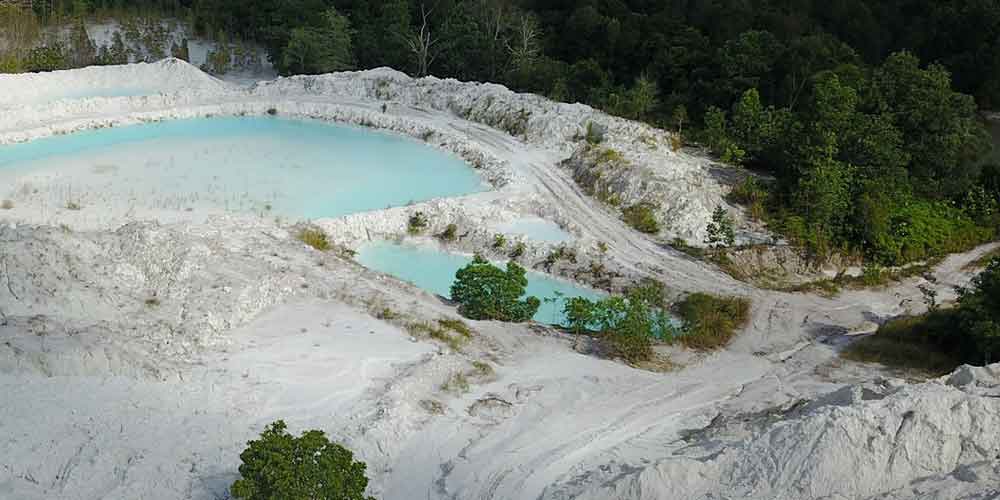The deep processing technology of kaolin
Kaolin is a clay mineral with kaolinite as the main component, commonly known as “china clay”, including: kaolinite, perlite, dickite, and halloysite. The crystalline chemical formula of kaolinite is AI4[Si4O10](OH)8 , which is a layered silicate mineral of 1:1 type. It consists of a silicon-oxygen tetrahedral layer and an aluminum-oxygen octahedral layer. The layers are composed of hydrogen-oxygen bonds. connect.

According to its texture and plasticity, it can be divided into hard kaolin, soft kaolin, and sandy kaolin. According to its genesis, it can be divided into coal series kaolin and non-coal series kaolin.
The gangue minerals of kaolin include feldspar, quartz, titanium oxide minerals, iron minerals, and mica. The main chemical components are silicon dioxide, aluminum oxide, iron oxide, calcium oxide and magnesium oxide, organic mixtures, and loss on ignition. , Alkali metal oxides, fluid anhydride.
The firing color of kaolin is white or close to white, and the maximum whiteness is greater than 95%; the hardness of soft kaolin is 1~2, and the hardness of hard kaolin can reach 3~4; it has good molding, drying and sintering properties; easy to disperse in water , Suspended, into a stable suspension; has excellent electrical insulation properties, the resistivity is greater than 1010Ω·cm-1 at 200°C. It has good resistance to acid solubility, the cation exchange capacity (CMC) is generally 0.03-0.05mmol/g, and it has good fire resistance, with a refractoriness of 1750-1790°C.
Kaolin has good properties such as plasticity, dispersibility, fire resistance, cohesiveness and stability, and has been widely used in many fields such as agriculture, refractory materials, papermaking, ceramics, and rubber.
With the emergence and development of modification technology and nanotechnology, modified kaolin and nano kaolin have shown more excellent performance, which greatly expands and extends the application field of kaolin. About 45% of global kaolin is used in papermaking, about 16% is used in refractory materials, about 15% is used in ceramics, and glass fiber and cement preparation fields each account for about 6%.
The deep processing technology of kaolin
The kaolin product after beneficiation and purification reaches the best quality in the natural state, but still does not meet the requirements of some applications, so further processing of kaolin is required. The deep processing of kaolin includes: calcination, superfine grinding, surface modification .
- Superfine grinding
In the process of ultrafine pulverization of kaolin, the product layer fractures to produce flaky particles. Therefore, the ultrafine grinding of kaolin is also called peeling. The stripping machines used in industry are mainly high-pressure homogenizers, mixing mills, etc.
![]()
The high-pressure homogenizer uses the shearing force generated by the mutual friction generated when the slurry is sprayed under high pressure and the crushing effect generated by the sudden pressure drop after the spraying, which destroys the kaolinite crystal structure and causes the hydrogen bond between the crystal layers. Fracture, causing the kaolin layers to burst and peel off one by one.
When pulverizing kaolin ultrafinely with a stirring mill, ceramic balls, glass balls, iron stone, and corundum are used as the pulverizing medium in order to avoid secondary pollution and ensure the whiteness of the product. Since the filling rate of the crushing medium will affect the production capacity of the mill, there are many media and the peeling effect is good, but the processing capacity is low, so the optimal filling rate should be determined through experiments based on the equipment performance.
- Calcination processing
The calcination of kaolin can eliminate the structural water in kaolinite minerals, and at the same time can remove organic pollution sources and some volatile substances. It is currently one of the most effective methods for processing kaolin. It can not only improve the purity and whiteness of kaolin, but also change the properties of kaolin, so that kaolin has properties that it did not have before calcination, such as: low density, large specific surface area, good covering properties, and good wear resistance. The satin firing process and equipment of kaolin mainly include inverted flame kiln calcination, rotary kiln calcination, vortex air flow calcination, and tunnel kiln calcination.
When kaolin is used as ceramics, an inverted flame kiln is usually used for calcination. Before the kaolin enters the kiln, the moisture content of the kaolin is controlled at about 15%, so that the kaolin will not cement during the calcination process and save fuel.
At present, most of the rotary kilns used are horizontal rotary kilns. The rotary kiln uses low-heat coal as the fuel. The rotation of the rotary kiln makes the kaolin continuously tumble, and the direction of movement is opposite to the direction of the high-temperature airflow, so that the kaolin and the high-temperature flue gas are thoroughly combined. Heat exchange, continuous production is possible.
The vortex air calcination uses a conical vortex to process the selected kaolin powder. During the calcination process, a rotating upward hot air flow is formed by a vortexer, and extremely fine materials are dispersed into a cone inner reaction chamber for calcination through a sprayer. At this time, the amorphous calcined kaolin obtained can be further heated, which will cause new The crystalline and physical state of the material is higher than the calcined kaolin in the first stage, and it has better characteristics.
The products calcined in the tunnel kiln have become sintered refractory clinker. In this process, the kaolin is made into a specific shape and sent to the tunnel kiln for calcination. The sintered material is crushed, classified, and made into a standard particle size. Enter the ball mill to grind to -120 mesh and -200 mesh or send to sieve to separate out 80-120 mesh.
